Common Orthodontic Issues
Crowding of the teeth
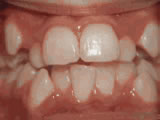
Crowding of the teeth is the most common problem associated with the need for orthodontic treatment. Many factors contribute to dental crowding. The most common reason for crowding is a discrepancy between the space available in each jaw and the size of the teeth. Crowding can lead to impacted teeth, a "bad bite", and an unesthetic appearance.
Open bite - Front teeth don't touch
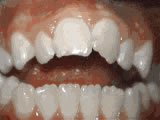
An openbite is defined as a lack of vertical overlap of the incisor (front) teeth. It results when the upper and lower front teeth do not touch when biting down. An openbite can be caused by abnormal growth of one of both jaws or it can be caused by a thumb or finger sucking habit. In some instances, a tongue thrust (which occurs when the tongue moves between the front teeth during swallowing) may also be a contributing factor to an openbite. When biting down, the space between the upper and lower front teeth causes excessive pressure on the back teeth. Over time, this excessive pressure can cause abnormal tooth wear on the back teeth, or problems with the gums and bone surrounding the back teeth.
Deep overbite - Lower front teeth bite into palate
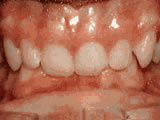
Overbite is defined as the vertical overlapping of the upper teeth over the lower teeth. A deep overbite (or deep bite) occurs when the upper front teeth completely (or mostly) cover the lower front teeth. Often, this causes the lower front teeth to bite on the gums behind the upper front teeth, causing damage to the gum tissue and underlying bone.
Underbite - Lower front teeth in front of upper teeth
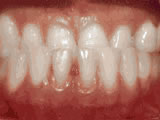
An underbite occurs when the lower front teeth protrude in front of the upper front teeth. It is often seen with a Class III malocclusion, where there is a large lower jaw, a small upper jaw, or a combination of the two. An underbite is also known as an anterior crossbite.
Spacing of teeth
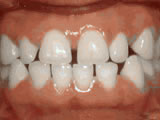
Spaces between teeth are another common problem associated with the need for orthodontic treatment. Like crowding, spacing is also often caused by a discrepancy between the space available in each jaw and the size of the teeth. Spacing can also arise from teeth that are missing or are smaller than normal.
Overjet - Protruding front teeth
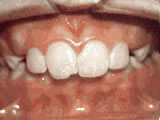
Overjet is defined as the horizontal protrusion of the upper teeth in front of the lower teeth. Overjet is often seen with a Class II malocclusion, which occurs when the top jaw is located ahead of the bottom jaw (due to a large top jaw, a small bottom jaw, or a combination of the two). Thumb and finger sucking habits can also cause excessive overjet.
Crossbite
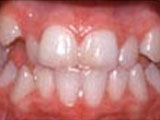
A crossbite occurs when the top teeth fit inside of the bottom teeth. In a normal jaw relationship, the top teeth should be located outside of the bottom teeth. A crossbite can occur with the front teeth (anterior crossbite) or with the back teeth (posterior crossbite). Posterior crossbites usually result from a narrow or constricted upper jaw. Crossbites can cause problems with biting and chewing.
Corrective Jaw Surgery
The vast majority of orthodontic patients can be treated with braces alone. Occasionally, however, patients may benefit from additional treatment, including a surgical approach. Corrective jaw surgery (orthognathic surgery) treats and corrects abnormalities of the facial bones, including the jaws. Often, these abnormalities cause difficulty associated with chewing, talking, sleeping and other routine activities. Orthognathic surgery corrects these problems and, in conjunction with orthodontic treatment, will improve the overall appearance of the facial profile. State-of-the-art materials such as titanium plates and miniature screws provide stability, strength, and predictability to your treatment. These advances in technology, procedures, and equipment reduce post-surgical recovery time, thus allowing patients to return to their normal routines soon after the surgery.

